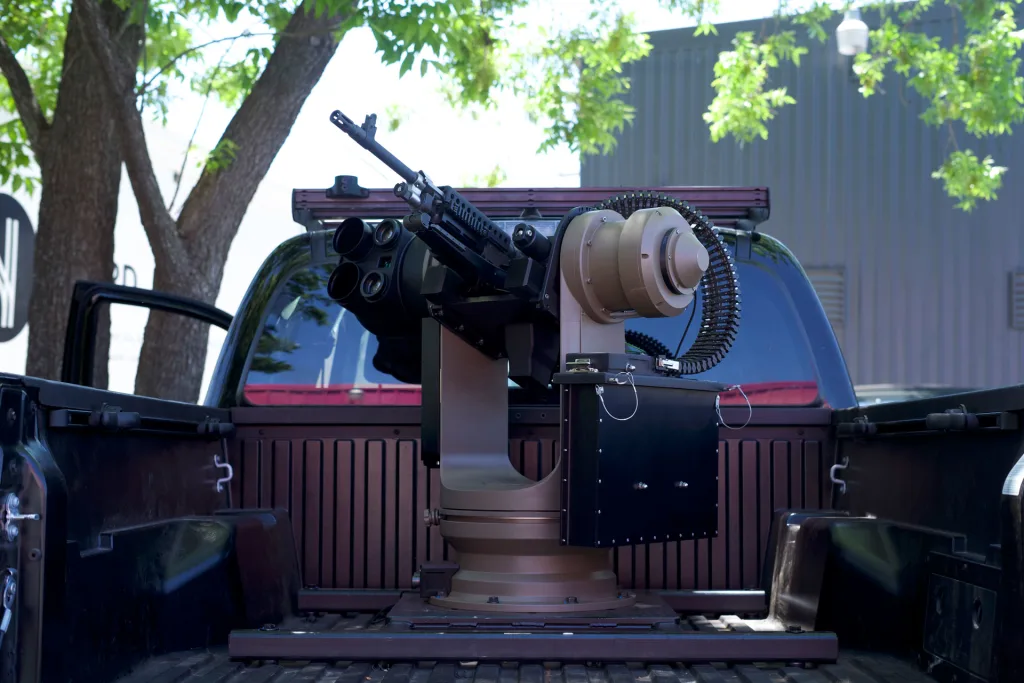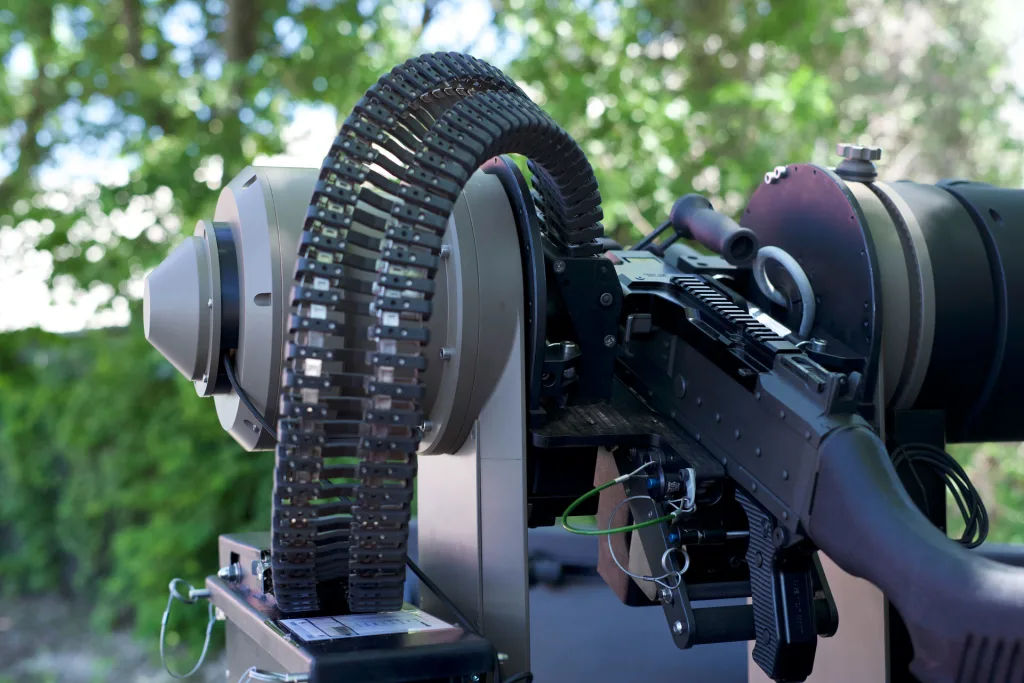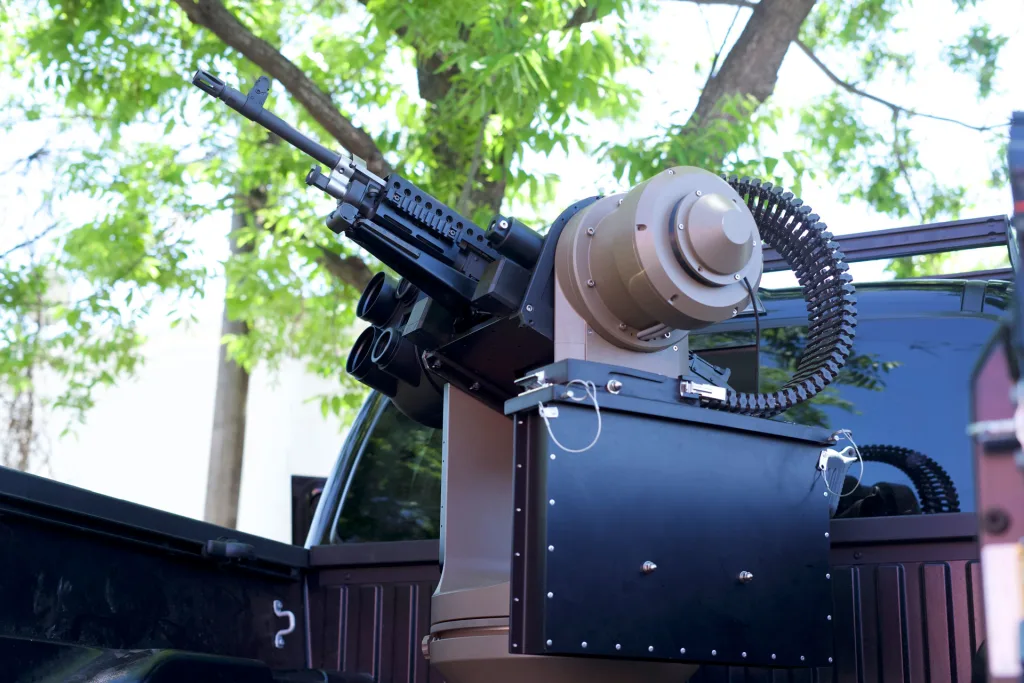Drones are increasingly part of modern warfare.
The aircraft, often equipped with explosives, have been deployed by both sides in Russia’s war on Ukraine. They’ve been part of recent skirmishes between India and Pakistan. And they’ve been used by Haitian government forces in the ongoing conflict with gangs around Port-au-Prince.
And to take down drones before they do damage, armed forces around the world and their military contractors have developed technologies to jam or hack drone control signals, zap them with lasers, or fry them with microwaves. But in this literal arms race, where combat drone developers will inevitably try to come up with ways to make their devices impervious to each new attack, an Austin-based startup called Allen Control Systems argues that the best defense might be one that relies on basic ballistics.
“We had the idea that we would use a cheap bullet to basically shoot these drones out of the sky,” says ACS President Steve Simoni, because “the drones of the future would be impervious to these [other] attacks.”
ACS has developed a robotic gun system called Bullfrog that uses AI and computer vision to detect drones and precisely fire at them. It’s inspired by the human-controlled Common Remotely Operated Weapon Station (CROWS) guns that the U.S. military already mounts on vehicles and ships. The Bullfrog is based around existing gun technology and uses ordinary bullets, like the standard NATO 7.62x51mm round, which makes it easy and cost-effective to load. But while the existing guns have troops use a joystick to aim the gun and fire at targets, humans often aren’t fast enough to take down a quick-moving drone, let alone a swarm of them.

“A human using a joystick isn’t good enough to do that,” says Simoni, who started his career as a naval officer before cofounding Bbot, a restaurant software and robotics startup acquired by Doordash. “So we basically redesigned that existing system from the ground up using a bunch of novel techniques in AI.”
The Bullfrog uses a set of cameras to detect and precisely locate drones, letting it fire what Simoni calls “a very precise sniper shot” at the fast-moving aircraft. Traditionally, attack drones have generally emphasized speed, flying quickly at targets like truck convoys to attack—generally moving predictably enough for the AI to easily target. But even if attackers adapt to have drones move more erratically, Simoni says ACS should still be able to fire more quickly than they can evade.
“Bullets travel very fast,” he says. “From the time we see it to [the time we] shoot, there’s not many places a drone can really move in that time period.”

The system, which ACS successfully demonstrated in a U.S. Army test earlier this year, where it took down all of seven target drones, still typically relies on a human in the loop. That is, when a vehicle is being attacked by drones, someone will look at a screen showing the incoming aircraft and select specific targets. But the AI and its cameras do the actual tracking and ballistics calculations necessary to accurately fire the gun and eliminate the drones.
Variants may also be able to handle scenarios where there’s a bigger swarm of drones than humans can practically target, but humans would still set the “rules of engagement,” like defining a field of view where the AI is allowed to target oncoming drones or specific safety requirements, Simoni says. In general, ACS’s software also lets users define areas where they don’t want bullets to be aimed for safety’s sake.
In demonstrations and tests, the company often fires at off-the-shelf drones from normal retail stores, or specific target drones provided by the military, which naturally restricts outside drones on its bases. As new drones evolve, ACS can also make virtual models of them, giving the AI practice recognizing and firing at them in a simulated environment. Using technology like Unreal Engine, the video game development tool, the company can create renderings of the drones in a variety of weather conditions and scenery, all without needing to fire any actual bullets or destroy any physical drones. The same approach can also teach the AI to distinguish other types of flying things, like birds and planes.
And while Russian and Ukrainian forces have already begun to circumvent drone jamming technology by replacing radio communications with long, thin fiber optic cables, and microwave attacks can be disrupted by adding conductive material to the right places on the drone, Simoni believes it’s just not physically feasible to build a drone that can reliably withstand bullets and still be light enough to nimbly fly.
“There’s not enough armor you could put on a drone to stop a bullet like that,” he says. An effectively armored drone would simply be too heavy.
The gun systems, on the other hand, are designed to be lightweight at about 200 pounds, and easy to bolt onto existing military vehicles and connect to vehicle power sources. Simoni says he envisions the system will be practical for both the U.S. and allies with smaller vehicles, where the guns can be mounted on a truck bed.

And while they can be used as “last lines of defense” for stationary targets like bases or power stations, Simoni says the Bullfrog is currently most practical for vehicles, thanks to its current range of about a kilometer.
“That’s a little too close for comfort for a base,” he says. “They want to probably engage the drones further out if they could.”
The technology also isn’t ideal for civilian use cases like protecting stadiums and events, where bullets aren’t the safest technology to stop errant drones, Simoni says. Alternatives like net guns might be a better solution there, he suggests.
ACS’s systems are slated for more military testing this year, demonstrating compatibility with a variety of military vehicles, with an eye toward battlefield deployment in early 2026. The company in March announced a $30 million Series A led by Craft Ventures along with existing investors Inspired Capital and Rally Ventures. Without revealing exact potential pricing, the company predicts its technology can lower the “cost per kill” to just a few dollars per drone.
Simoni says the company aims to help the military prepare for a future where machines, not humans, do the bulk of fighting.
“The future of conventional warfare is mostly going to be robots shooting at other robots,” he says. “It is far too dangerous to be out there, so I don’t think there’s going to be a lot of human engagement.”
Chcete-li přidat komentář, přihlaste se
Ostatní příspěvky v této skupině


As artificial intelligence’s influence continues to spread deeper into pop culture, major record labels are starting negotiations with AI companies to ensure they—and their artists—are prope

“Believe nothing. not even people’s runs,” a viral post on X reads.
<figure class="wp-block-embed is-type-rich is-provid

Two years after the launch of ChatGPT, return on investment in generative AI has been e

Migraine sufferers have heard it all: ice hats, essential oils, ginger tea. The latest advice? Head to McDonald’s and order a large Coca-Cola and fries, dubbed the “McMigraine meal.”
One

As the founder and board chair of the tech nonprofit Products That Count, I’ve had a front-row seat to AI’s domination of the tech world over the past couple of years. A few years ago, just a sliv

The U.S. Food and Drug Administration said on Monday that it had launched a generative
